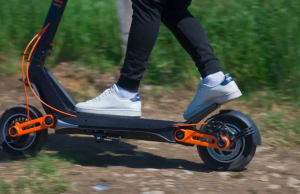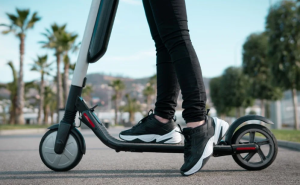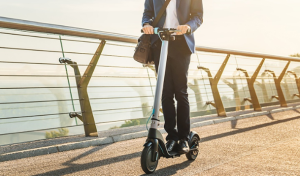Yes, riding a scooter can burn fat. A 155-pound person can burn approximately 200-300 calories in 30 minutes.
Mechanics of Fat Burning
The mechanics of fat burning involve a complex interplay between various physiological processes. When the body needs energy, it can break down fat stores through a process called lipolysis. This process releases fatty acids into the bloodstream, which can then be transported to cells and used for energy. The efficiency of this process can vary depending on factors such as diet, exercise, and overall metabolic rate.
How the Body Burns Fat
The body primarily burns fat through aerobic metabolism, which requires oxygen. During this process, fatty acids are broken down in the mitochondria of cells to produce ATP, the energy currency of the cell. The rate at which the body burns fat can be influenced by factors such as the intensity of physical activity and the individual’s metabolic rate. At rest, the body might burn approximately 60-70% of its calories from fat, but this percentage can decrease to 35-50% during moderate to high-intensity exercise.
Role of Cardiovascular Exercise in Fat Burning
Cardiovascular exercise is crucial for enhancing the body’s ability to burn fat. Activities such as running, cycling, and swimming increase the heart rate and improve the efficiency of the cardiovascular system. Enhances the delivery of oxygen to muscles, which is essential for the aerobic breakdown of fat. Studies have shown that individuals who engage in regular cardiovascular exercise can have a higher resting metabolic rate, meaning they burn more calories at rest, including calories from fat. A study might find that participants who engage in 30 minutes of moderate-intensity cycling five days a week can experience a significant increase in their fat-burning capacity.
Scooter Riding as a Cardio Exercise
Scooter riding can be considered a form of cardiovascular exercise, particularly when performed at a moderate to high intensity. It involves continuous movement that can increase the heart rate and improve overall cardiovascular health. While it may not be as intense as some other forms of cardio, such as running or cycling, it can still provide a beneficial workout, especially for those looking for a low-impact option.
Intensity of Scooter Riding
The intensity of scooter riding can vary based on factors such as speed, terrain, and rider effort. Riding a scooter at a brisk pace on flat terrain can be considered a moderate-intensity exercise, similar to brisk walking. The average speed of a brisk scooter ride might range from 5 to 10 miles per hour, depending on the rider’s effort and the type of scooter used. To increase the intensity, riders can tackle hills or increase their speed, which can elevate the heart rate further and lead to greater calorie burn.
Comparing Scooter Riding to Other Cardio Exercises
When comparing scooter riding to other cardio exercises, it’s important to consider factors such as intensity, calorie burn, and impact on the joints. Running at 6 miles per hour can burn approximately 300-400 calories in 30 minutes for a person weighing 155 pounds, whereas scooter riding at a moderate pace might burn around 200-300 calories in the same timeframe. Scooter riding has the advantage of being lower impact than running, making it a more suitable option for individuals with joint issues or those seeking a less strenuous form of exercise.
Calculating Calories Burned While Riding a Scooter
Calculating calories burned while riding a scooter involves taking into account several factors that can influence energy expenditure. These factors include the rider’s weight, the intensity and duration of the ride, and the terrain.
Factors Affecting Calorie Burn
Several factors affect calorie burn during scooter riding:
- Weight of the Rider: Heavier individuals tend to burn more calories. For example, a person weighing 150 pounds might burn approximately 200 calories in 30 minutes of moderate scooter riding, while a person weighing 200 pounds might burn around 270 calories in the same time.
- Riding Intensity: The faster and more vigorously you ride, the more calories you’ll burn. Riding at a brisk pace can significantly increase calorie expenditure compared to a leisurely ride.
- Terrain: Riding uphill or on uneven surfaces requires more effort, leading to higher calorie burn. Riding on flat terrain, on the other hand, is less demanding.
- Duration: The longer the ride, the more calories burned. Consistent, longer rides can contribute significantly to overall calorie expenditure.
Estimating Calorie Burn During Scooter Rides
To estimate calorie burn during scooter rides, you can use online calculators or fitness trackers that take into account the factors mentioned above. These tools typically require inputting your weight, the duration of your ride, and the intensity level to provide an estimate of calories burned.
For a rough estimate, a moderate-intensity scooter ride might burn between 150 to 250 calories per half hour for a person weighing around 155 pounds. This estimate can vary based on the specific conditions of each ride.
Incorporating Scooter Riding into a Weight Loss Plan
Incorporating scooter riding into a weight loss plan can be an effective strategy for those looking to increase physical activity and burn calories. It’s a low-impact exercise that can be easily integrated into daily routines, making it accessible for individuals at various fitness levels.
Setting Realistic Goals
Setting realistic goals is crucial when incorporating scooter riding into a weight loss plan. A realistic goal might be to ride the scooter for 30 minutes, three to four times a week, aiming to burn an estimated 200-300 calories per session. It’s important to gradually increase the duration and intensity of the rides to avoid burnout and reduce the risk of injury.
Combining Scooter Riding with Other Weight Loss Strategies
To maximize the effectiveness of scooter riding for weight loss, it’s beneficial to combine it with other weight loss strategies. These may include:
- Dietary Changes: Adopting a balanced diet that creates a caloric deficit is essential for weight loss. Focus on incorporating whole foods, lean proteins, and plenty of fruits and vegetables.
- Strength Training: Incorporating strength training exercises two to three times a week can help build muscle mass, which in turn increases the body’s metabolic rate and enhances fat burning.
- Hydration: Staying well-hydrated is important for overall health and can aid in weight loss by helping to control appetite and enhance physical performance during exercise.
- Consistency: Maintaining a consistent exercise routine and healthy eating habits is key to long-term weight loss success.
Incorporating scooter riding into a weight loss plan can be a fun and effective way to increase physical activity and burn calories. By setting realistic goals and combining scooter riding with other weight loss strategies, individuals can create a comprehensive and sustainable approach to achieving their weight loss objectives.



